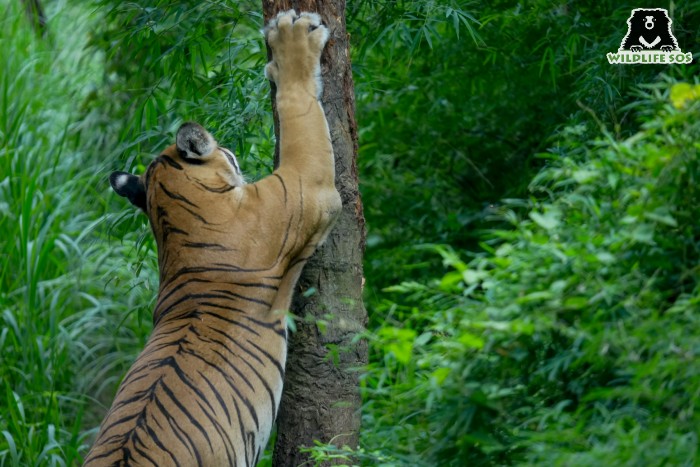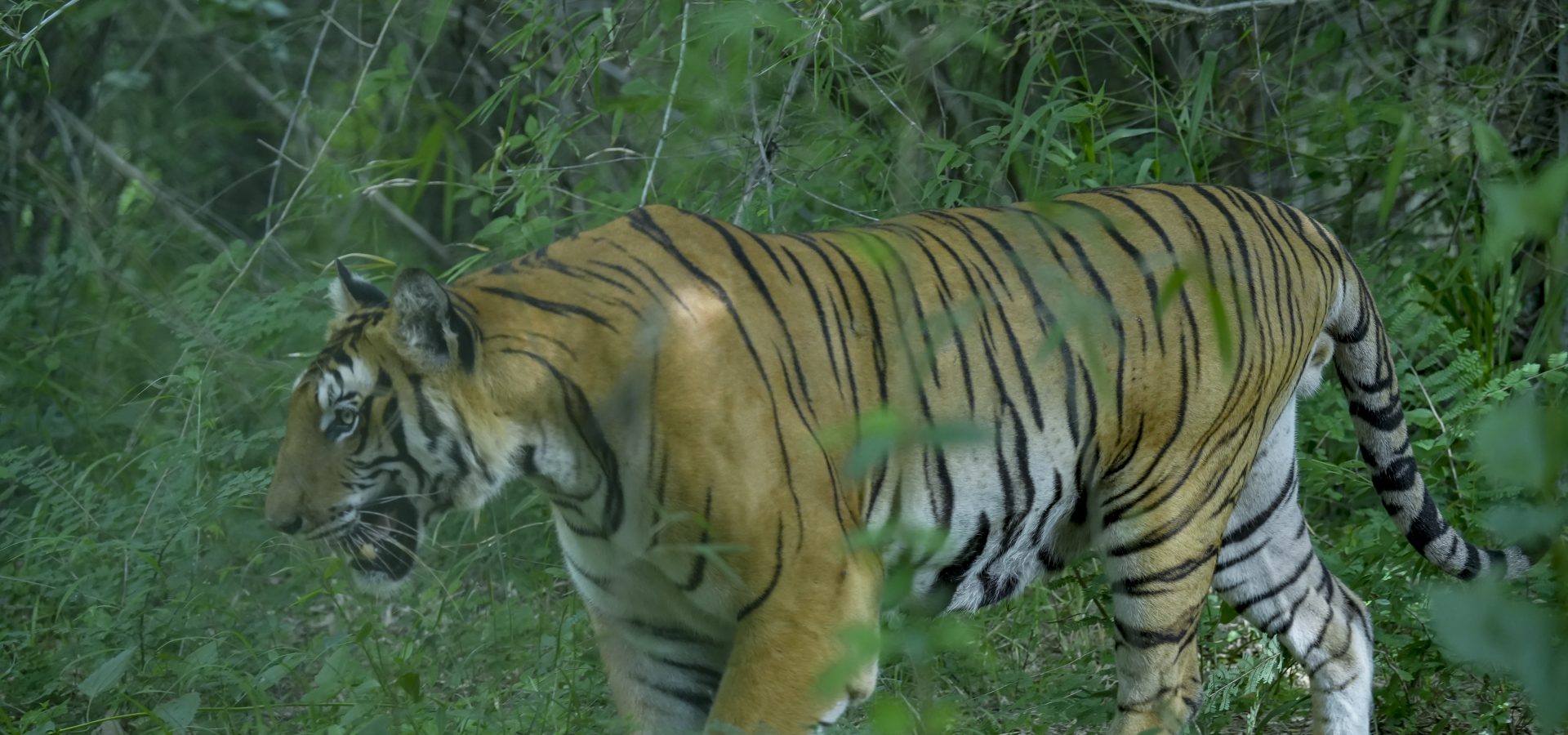As the rising sun welcomes a new day, the lush green cover of Bannerghatta Bear Rescue Centre erupts with birdsong. However, beyond the birds and rescued bears, another animal calls this ecological haven a home. Gopal, the tiger, strolls into view, breaking the variegated pattern of green with stripes of black and orange!
The Bengal tiger’s awe-inspiring frame and kingly stature in the wild has fascinated people across generations, lending the animal the title of “Royal” Bengal tiger.
Gopal upholds this royalty as he enters his geriatric years. The regal tiger is known for being as vivacious and energetic as he was at the time of his arrival! While he receives the attention, love and dedicated care that he requires from our team, the story that precedes his presence at our centre was a series of unfortunate incidents.
What better time to announce his entry with a roar than on World Tiger Day! On this occasion, we introduce our supporters to this grand old feline, who was able to find a new lease on life, thanks to the tireless efforts of Wildlife SOS and Born Free Foundation.

Finding a New Home for Gopal
In 2014, the Born Free Foundation alerted us of a particular six year old tiger from the Nagarhole National Park’s Thimathi Range, that had become embroiled in human-animal conflict.
Such an action found grave consequences for both human and wildlife. To dispel the chaos and fear caused by predators, locals have often engaged in retaliatory killings. To ensure this particular tiger did not meet such a fate, we immediately decided to bring him away from high risks to his survival!
The Wildlife SOS Bannerghatta Bear Rescue Centre (BBRC) has become an effective alternative habitat for rescued sloth bears. The large centre is located in the midst of the Bannerghatta Biological Park, and therefore proved to be the perfect place to rehabilitate this majestic big cat. All our centres are designed with the aim to closely simulate an animal’s natural environment, and Gopal’s new residence has been no different.
Nearly a Decade of Dedicated Care
“Tyger Tyger burning bright,
In the Forests of the Night.”
William Blake hit the right notes with his famous poem that remarks on tigers. Bengal tigers do prefer to hunt at night, but they are expert ambush predators during day time as well. We designed Gopal’s new enclosure with this idea in mind and divided it into two large fields or kraals.
The day kraal is a sizable space where trees, bushes, caverns and hiding places provide him with the freedom to run around, till he decides to head to his retreat. He romps around in the day kraal for most of his time and enters the night kraal only for medical examinations or during his feeding time. Tigers are among the few felines that enjoy a good swim, and Gopal can be spotted indulging himself in the pool inside this enclosure.
Fortunately, Gopal remains in good health. To ensure his well being and upkeep, our veterinarians routinely provide him with probiotics and vitamin pills. Gopal retains his natural instincts of the wild and is a true introvert, just like his kind. While he has become accustomed to his caregivers’ scent and presence, he skilfully recedes into the greenery and rock formations in the presence of strangers.
Our veterinarians regularly monitor his health. This involves taking his temperature, while looking for any wounds or illnesses. Furthermore, his body and coat are checked for ticks, while his faeces are analysed for parasites. A blood test is also conducted every few months. He also receives annual immunisations to prevent viral illnesses.
The Quandary of Human-Tiger Conflict in India
With rapid loss of forest cover, climate change and poaching, tigers often become victims of human activities. Wildlife SOS has busted several illegal trading rings to recover pelts of tigers from them. Due to transnational trade engaging in tiger skin and live animals, the world’s biggest cat has witnessed a drastic dip in population.
The government launched Project Tiger in 1973 in an attempt to save India’s national animal. The initiative began at the Jim Corbett National Park and eight other reserves spread across different Indian states. Today, there are 54 tiger reserves in the nation, covering a total area of around 75,000 square kilometres.
Due to this project, the number of tigers has increased from less than 2,000 in 1973 to 3,167 at present. Tigers are important as a flagship species for the ecosystem. Their activities keep prey populations of ungulates in check, which in turn prevents overgrazing. Creating habitats for tigers also helps other animals like sloth bears that often share the same habitat.
While strict vigilance and legislation have helped us check poachers’ activities, human-tiger conflict is a murkier area to navigate. Many tigers fall victim to open, uncovered wells across the country and either drown or starve to death. They must also contend with the reality that roughly human activities have destroyed roughly 93% of their natural habitat.
Thankfully, our brave wildlife warriors remain on the frontlines. They protect and offer treatment to tigers that have become injured or are stuck in perilous situations.
Help Gopal and his Kind!
Gopal’s story illustrates how there are not always clear heroes or villains in the grand narrative of conservation. Farmers need and depend on their livestock. Alternatively, tigers and other hypercarnivores have to search for alternative food due to a dwindling prey base. How many of Gopal’s kins stared at the barrel of a gun during their final moments?
While our fight for these magnificent animals will continue, we must celebrate how Gopal triumphantly completes nearly a decade with us! Dearest Gopal is away from human-animal conflict and the poacher’s evil eye, and resides safely at the Bannerghatta Tiger Sanctuary.
To help us take care of this captivating animal, consider sponsoring him! Share Gopal’s story to spread awareness on the threats faced by tigers in the wild. Together, we can ensure that the future of Bengal tigers will remain “burning bright”!





